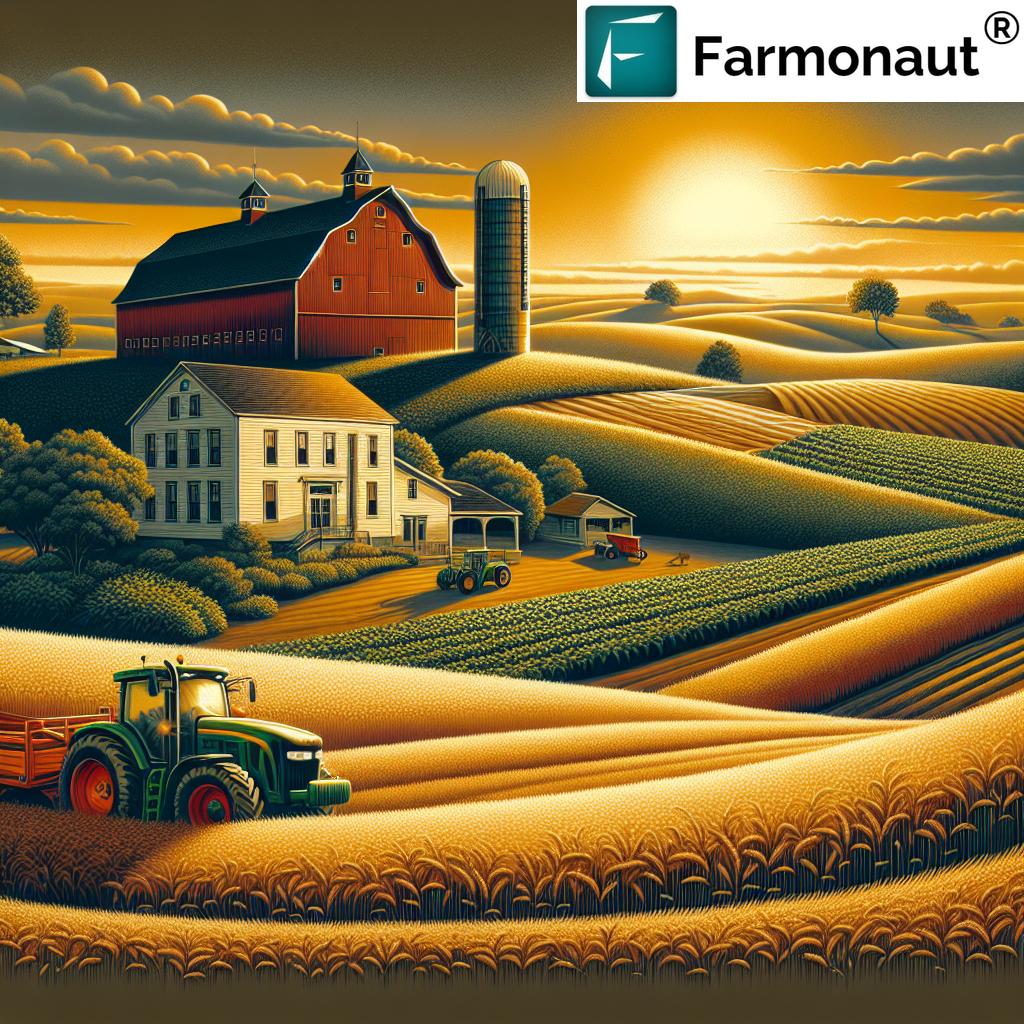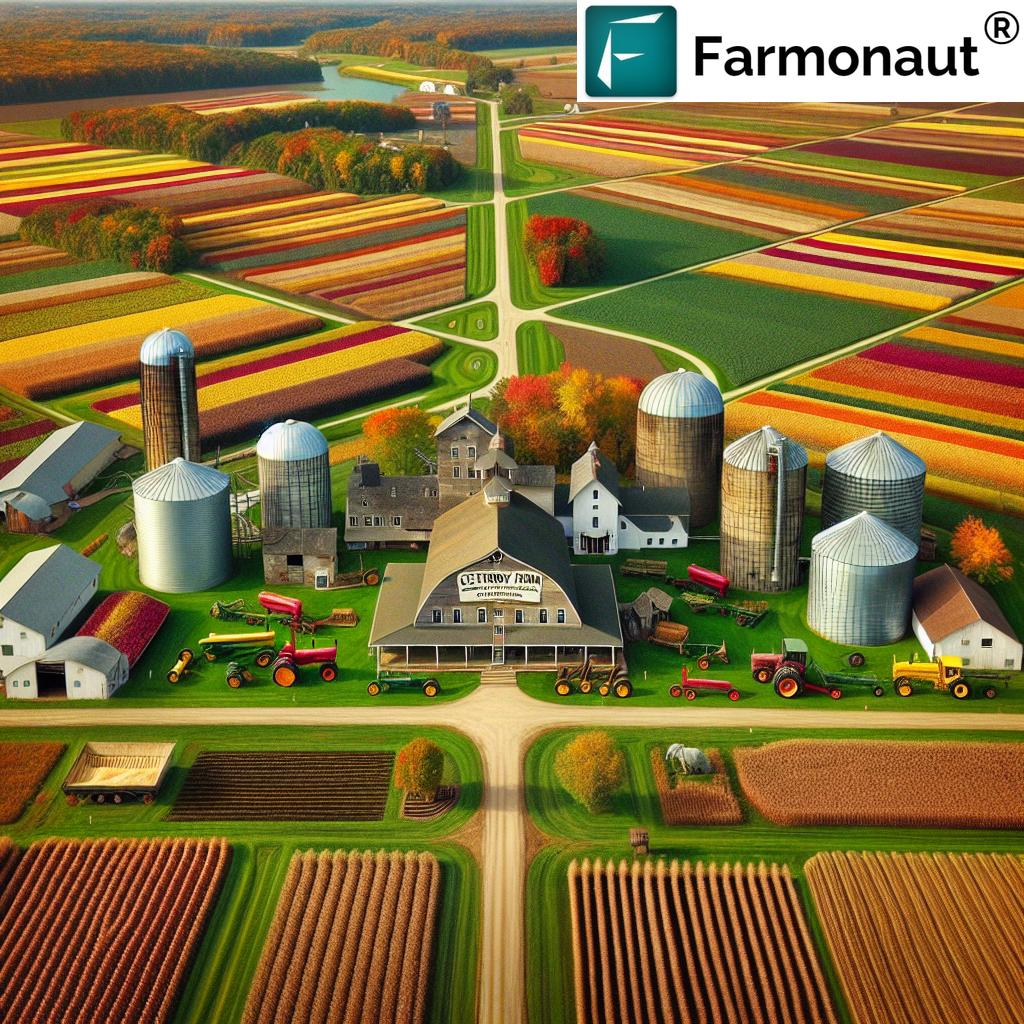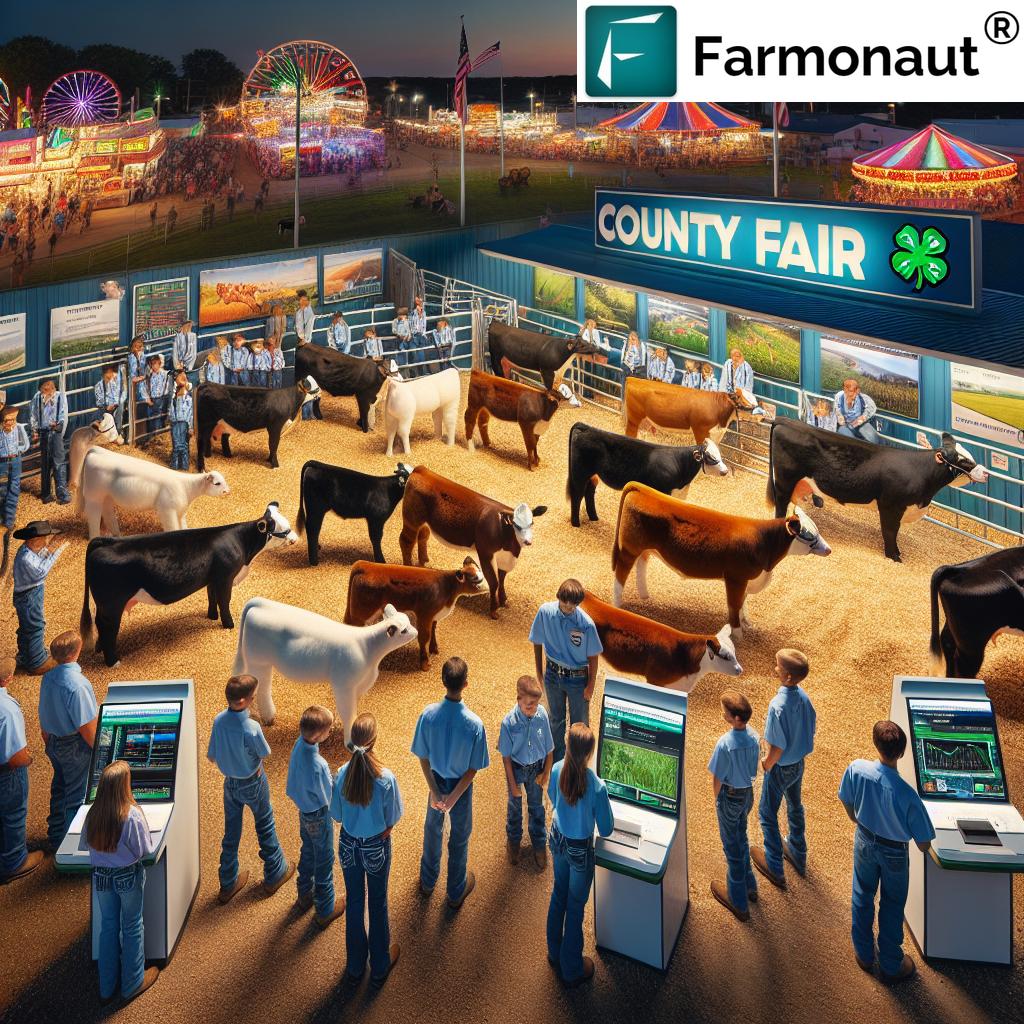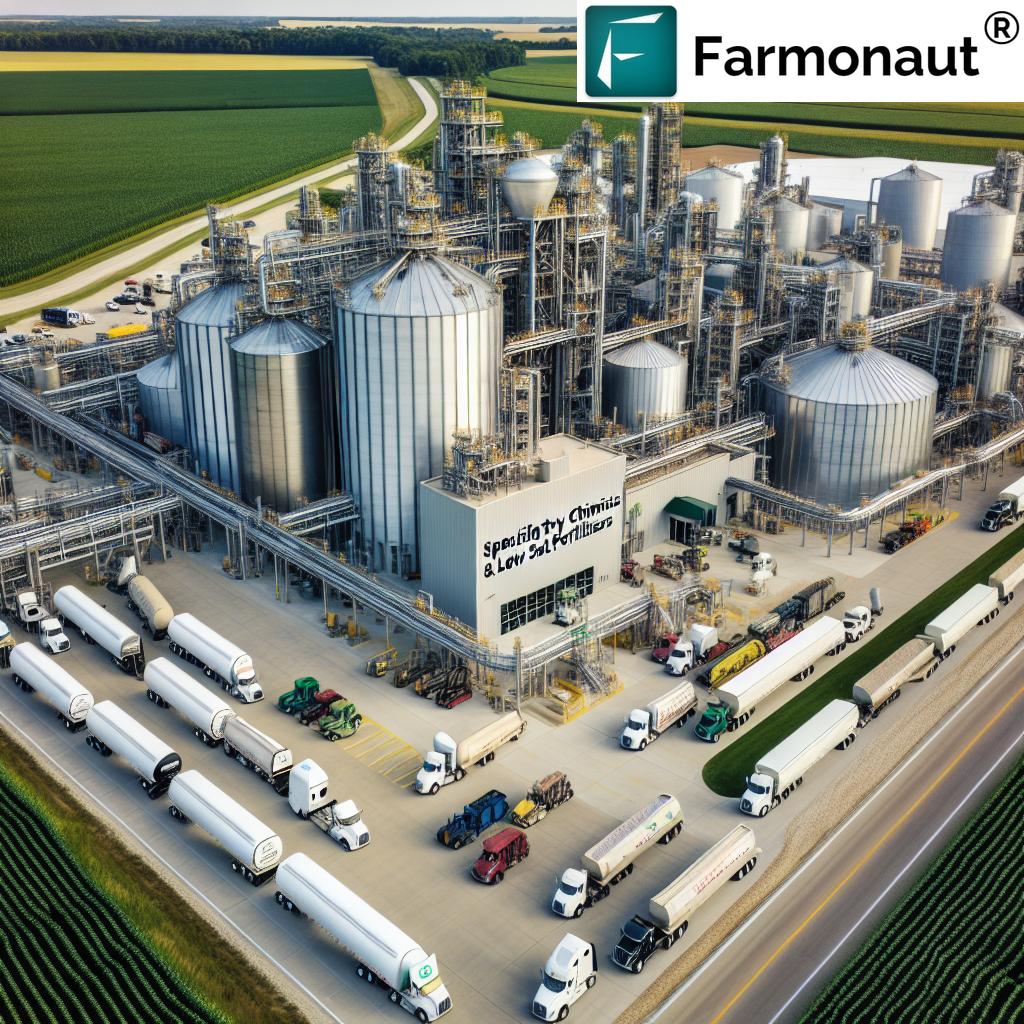Preserving Ohio’s Agricultural Legacy: How Century Farms Embrace Sustainable Farming for Future Generations
“Ohio’s Century Farms Program has recognized over 2,000 farms that have been in continuous operation for more than 100 years.”
As we embark on a journey through Ohio’s rich agricultural tapestry, we find ourselves immersed in a legacy that spans centuries. The Buckeye State’s historic farms stand as living monuments to the resilience, innovation, and stewardship of generations of farmers. In this exploration of Ohio’s agricultural heritage, we’ll discover how these century-old farms are not just preserving the past, but embracing sustainable practices to secure a thriving future for agriculture in our state.
The Roots of Ohio’s Farming Legacy
Long before Ohio achieved statehood, the fertile lands we now call home were cultivated by Native American tribes. These indigenous peoples were the original stewards of the land, developing sophisticated agricultural practices that sustained their communities for generations. As European settlers arrived, they built upon this foundation, establishing farms that would become the cornerstones of Ohio’s agricultural economy.
Today, we stand on the shoulders of these pioneers, continuing their legacy of innovation and adaptation. The Ohio Historic Family Farms Program serves as a testament to this enduring agricultural tradition, recognizing farms that have been in continuous operation for over a century.

The Oldest Operating Farm in Ohio: A Living Time Capsule
In Adams County, we find a remarkable piece of living history – the Smiley farm. Established in 1772, this farm holds the distinction of being the oldest continuously operating farm registered with Ohio’s Historic Family Farms Program. John Smiley, the seventh-generation steward of this land, carries with him stories that predate Ohio’s statehood.
“Our farm is unique,” Smiley proudly states, “It was originally acquired from King George III of England.” This connection to pre-Revolutionary America underscores the deep roots of Ohio’s agricultural heritage.
The Smiley farm isn’t just a relic of the past; it’s a thriving agricultural operation that has adapted to changing times. From the fields where John learned to drive a tractor to the pastures where he still raises cattle, every acre tells a story of resilience and adaptation.
Century Farms: Guardians of Ohio’s Agricultural Traditions
Across all 88 counties of Ohio, we find Century Farms that have weathered the storms of time, economic fluctuations, and technological revolutions. These farms, numbering over 2,000, form the backbone of Ohio’s agricultural legacy. Each one represents a family’s commitment to the land, a century or more of hard work, innovation, and stewardship.
Brian Baldridge, director of the Ohio Department of Agriculture, emphasizes the significance of these long-established farms: “These Century Farms are more than just businesses; they’re living museums of our state’s agricultural history. They’ve seen the transition from horse-drawn plows to GPS-guided tractors, all while maintaining a deep connection to the land.”
Challenges Facing Ohio’s Historic Farms
Despite their historical significance, Ohio’s Century Farms face numerous challenges in the modern agricultural landscape. Between 2017 and 2022, our state witnessed the loss of approximately 300,000 acres of farmland. This alarming statistic underscores the pressures facing our agricultural communities.
- Development Pressure: As urban areas expand, prime farmland is often targeted for development.
- Economic Challenges: Small farms struggle to compete with larger operations that can leverage economies of scale.
- Succession Planning: Ensuring the next generation is willing and able to continue farming operations is a growing concern.
- Climate Change: Shifting weather patterns and extreme events pose new challenges for crop and livestock management.
Despite these obstacles, Ohio’s historic farms are finding innovative ways to adapt and thrive.
Embracing Sustainable Farming Practices
“Sustainable practices like no-till farming and cover cropping are helping preserve Ohio’s agricultural legacy across all 88 counties.”
In the face of these challenges, Ohio’s Century Farms are leading the charge in adopting sustainable farming practices. These methods not only help preserve the land for future generations but also improve productivity and resilience.
No-Till Farming: Preserving Soil Health
One of the most significant shifts in modern agriculture has been the adoption of no-till farming. This practice minimizes soil disturbance, helping to:
- Reduce erosion
- Improve soil structure
- Increase organic matter content
- Enhance water retention
Geoff Mavis, whose family has farmed 900 acres in Fayette County since 1840, is a staunch advocate of no-till farming. “We’ve seen a dramatic improvement in our soil health since adopting no-till practices,” Mavis explains. “It’s not just about preserving the land; it’s about making it better for the next generation.”
Cover Cropping: Building Soil Fertility
Another sustainable practice gaining traction among Ohio’s historic farms is cover cropping. By planting crops like clover, rye, or vetch during off-seasons, farmers can:
- Prevent soil erosion
- Suppress weeds
- Improve soil fertility
- Enhance biodiversity
“Cover cropping has been a game-changer for us,” says Emily Johnson, a fifth-generation farmer in Licking County. “We’ve seen improved yields and reduced input costs, all while knowing we’re building healthier soils for the future.”

Precision Agriculture: Maximizing Efficiency
While Century Farms honor their heritage, they’re not shy about embracing cutting-edge technology. Precision agriculture tools, such as GPS-guided tractors and drone-assisted crop monitoring, are helping these historic farms optimize resource use and minimize environmental impact.
Here’s where innovative solutions like Farmonaut come into play. As a pioneer in agricultural technology, Farmonaut offers advanced, satellite-based farm management solutions that can benefit Ohio’s historic farms. Through its android, iOS, web/browser App, and API, Farmonaut makes precision agriculture accessible and affordable.
Farmonaut’s platform provides real-time crop health monitoring, AI-based advisory systems, and resource management tools. These technologies can help Ohio’s Century Farms:
- Monitor crop health using multispectral satellite imagery
- Make informed decisions about irrigation and fertilizer use
- Optimize pest management strategies
- Track and reduce their carbon footprint
By integrating these modern tools with traditional farming wisdom, Ohio’s historic farms are positioning themselves for success in the 21st century and beyond.
Preserving Farmland for Future Generations
Recognizing the importance of farmland preservation, Ohio has implemented several programs to protect agricultural land from development pressures. One such initiative is the use of agricultural easements.
Agricultural Easements: A Tool for Preservation
Agricultural easements are legal agreements that permanently protect farmland from non-agricultural development. Farmers like Geoff Mavis have taken proactive steps to secure their land’s future by placing it under such easements.
“By placing our farm under an agricultural easement, we’re ensuring that this land will always be dedicated to farming, no matter who owns it in the future,” Mavis explains. “It’s our way of honoring the legacy of those who came before us and safeguarding it for generations to come.”
The Ohio Historic Family Farms Program
The Ohio Historic Family Farms Program plays a crucial role in recognizing and supporting farms that have been in continuous operation for over a century. This program not only honors the historical significance of these farms but also provides resources and support to help them continue their legacy.
Benefits of the program include:
- Recognition through official Century Farm designation
- Access to educational resources on sustainable farming practices
- Networking opportunities with other historic farms
- Promotion of farm products through state-sponsored marketing initiatives
The Role of Technology in Preserving Agricultural Heritage
As we look to the future of Ohio’s historic farms, technology plays an increasingly important role in preserving agricultural heritage while enhancing productivity and sustainability. Farmonaut’s suite of tools offers Century Farms a way to bridge the gap between traditional farming methods and modern agricultural technology.
For example, Farmonaut’s satellite-based crop health monitoring can help farmers like John Smiley and Geoff Mavis make data-driven decisions about their operations. By providing real-time insights into vegetation health (NDVI) and soil moisture levels, Farmonaut enables these historic farms to optimize their resource use and improve crop yields.
Moreover, Farmonaut’s AI-driven Jeevn AI advisory system can provide personalized recommendations tailored to the unique needs of each farm. This technology can help Century Farms adapt to changing climate conditions and market demands while maintaining their traditional practices.
Ohio’s Century Farms at a Glance
| County Name | Number of Century Farms | Oldest Farm (Year Established) | Primary Crop/Livestock | Sustainable Practices Adopted |
|---|---|---|---|---|
| Adams | 35 | 1772 | Cattle, Tobacco | No-till farming, Cover cropping |
| Fayette | 28 | 1840 | Corn, Soybeans | Precision agriculture, Crop rotation |
| Licking | 42 | 1808 | Dairy, Wheat | Conservation tillage, Integrated pest management |
| Wayne | 55 | 1815 | Dairy, Poultry | Rotational grazing, Methane digesters |
| Ashtabula | 31 | 1805 | Grapes, Apples | Integrated pest management, Drip irrigation |
This table provides a snapshot of Ohio’s Century Farms across different counties, highlighting their longevity, primary agricultural activities, and the sustainable practices they’ve adopted. It’s a testament to the diversity and resilience of Ohio’s agricultural heritage.
The Future of Ohio’s Agricultural Heritage
As we look to the future, the preservation of Ohio’s agricultural heritage is more important than ever. Century Farms serve as living laboratories, demonstrating how traditional farming wisdom can be combined with modern sustainable practices to create resilient, productive agricultural systems.
By embracing technologies like those offered by Farmonaut, Ohio’s historic farms can:
- Improve crop yields while reducing environmental impact
- Adapt to changing climate conditions
- Attract younger generations to farming through the integration of technology
- Enhance their economic viability, ensuring their continued operation for generations to come
As we continue to support and celebrate Ohio’s Century Farms, we’re not just preserving our past; we’re cultivating a sustainable future for agriculture in our state. These farms serve as beacons of innovation, stewardship, and resilience, inspiring the next generation of farmers to carry on Ohio’s rich agricultural legacy.
FAQ Section
Q: What is a Century Farm in Ohio?
A: A Century Farm in Ohio is a farm that has been owned and operated by the same family for at least 100 consecutive years. These farms are recognized by the Ohio Historic Family Farms Program for their longevity and contribution to the state’s agricultural heritage.
Q: How many Century Farms are there in Ohio?
A: Ohio has recognized over 2,000 Century Farms across all 88 counties in the state.
Q: What is the oldest continuously operating farm in Ohio?
A: The oldest continuously operating farm registered with Ohio’s Historic Family Farms Program is the Smiley farm in Adams County, established in 1772.
Q: How are Ohio’s Century Farms adapting to modern agricultural challenges?
A: Ohio’s Century Farms are adapting by embracing sustainable farming practices such as no-till farming, cover cropping, and precision agriculture. Many are also utilizing advanced technologies like satellite-based crop monitoring and AI-driven advisory systems to optimize their operations.
Q: What is an agricultural easement?
A: An agricultural easement is a legal agreement that permanently protects farmland from non-agricultural development. It ensures that the land remains dedicated to agricultural use, regardless of ownership changes.
Q: How can technology help preserve Ohio’s agricultural heritage?
A: Technology, such as Farmonaut’s satellite-based farm management solutions, can help Ohio’s historic farms improve efficiency, reduce environmental impact, and make data-driven decisions. This enables these farms to remain economically viable while preserving traditional farming practices.
Conclusion: Cultivating a Sustainable Future
As we’ve journeyed through Ohio’s rich agricultural landscape, we’ve seen how Century Farms are not just relics of the past, but vibrant, evolving operations that hold the key to our agricultural future. By blending time-honored traditions with cutting-edge sustainable practices and technologies, these farms are charting a course for the next century of Ohio agriculture.
The story of Ohio’s Century Farms is one of resilience, innovation, and unwavering commitment to the land. As we face the challenges of the 21st century – from climate change to food security – these historic farms stand as beacons of hope and inspiration. They remind us that with careful stewardship, innovative thinking, and a deep connection to the land, we can preserve our agricultural heritage while building a sustainable future for generations to come.
Let us continue to support and celebrate Ohio’s Century Farms, for in their fields we find not just our history, but the seeds of our future.
Earn With Farmonaut
Earn 20% recurring commission with Farmonaut’s affiliate program by sharing your promo code and helping farmers save 10%. Onboard 10 Elite farmers monthly to earn a minimum of $148,000 annually—start now and grow your income!
Learn more about Farmonaut’s Affiliate Program
Farmonaut Subscriptions
For developers interested in integrating Farmonaut’s powerful satellite and weather data into their own applications, explore our API and API Developer Docs.















